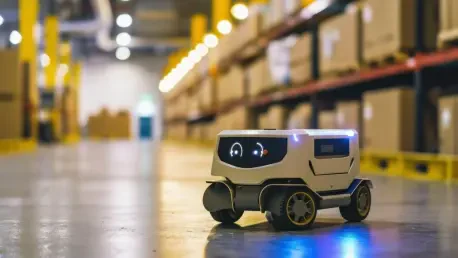Welcome to an insightful conversation with Rohit Laila, a seasoned veteran in the logistics and supply chain industry with decades of experience spanning supply chain management and delivery. Rohit’s passion for technology and innovation has positioned him as a thought leader in warehouse automation and third-party logistics (3PL) operations. In this interview, we dive into the cutting-edge multi-user distribution center in Coventry, UK, exploring how automation transforms operations for major retailers, the role of innovative technologies like robots in enhancing efficiency, and the strategies behind managing fast-paced consumer demands. We’ll also touch on the broader implications of these advancements within a global logistics network and the future of automation in the industry.
How did the idea for the multi-user distribution center in Coventry come about, and what unique features set it apart from other facilities?
I’m thrilled to talk about our Coventry facility at Cross Point Business Park. This center was designed to address the growing need for flexible, high-speed logistics solutions, especially for retailers with complex omnichannel demands. What sets it apart is the high degree of automation we’ve integrated across three mezzanine floors for storage, picking, and packing. It’s a multi-user setup, meaning it can serve multiple clients efficiently, but right now, it’s heavily tailored to support a major beauty retailer with both e-commerce and in-store fulfillment. The combination of advanced tech and strategic layout design makes it a standout in terms of speed and adaptability.
Can you share how this facility specifically caters to the needs of a beauty retailer with both online and brick-and-mortar operations?
Absolutely. For a beauty retailer, the challenge is balancing the surge in online orders—about 30% of consumer purchases in the UK are made digitally—with regular store replenishments. At Coventry, we process an average of 7,000 online orders daily, mostly during the busy afternoon and evening shifts. For the physical stores, we manage deliveries every other day to their seven UK locations, ensuring stock levels are always optimized. Our systems track inventory meticulously, so we can prioritize fast-moving items and meet tight delivery windows, whether it’s a customer clicking ‘buy’ online or a store needing a restock.
What role does automation play in keeping operations smooth at this warehouse, and how does it impact daily workflows?
Automation is the backbone of our efficiency here. We’ve implemented a range of technologies, from warehouse control systems to robotics, to handle the high volume of orders without hiccups. It streamlines everything from inbound scanning to outbound dispatch. By automating repetitive tasks, we reduce human error and speed up processes, especially during peak demand. It also allows our team to focus on more strategic roles, like analyzing data to tweak layouts or improve workflows. The result is a seamless operation that can scale up when needed, keeping both online customers and stores happy.
Let’s dive into the ‘Chuck’ robots. How do they assist in the picking process, and what’s the experience like for the human workers alongside them?
The ‘Chuck’ robots are a game-changer for our picking operation. We have 45 of these ‘follow me’ bots, and they’re programmed to guide pickers through the warehouse along pre-set routes. Using sophisticated software, they indicate which items to pick and which boxes to use for each order. The human picker just scans and places the item, while the bot handles navigation. It’s a huge relief for our staff because it cuts down on walking time and decision fatigue. Honestly, it feels like having a reliable co-worker who never gets lost, and it boosts both speed and accuracy.
Beauty trends shift rapidly. How do you manage inventory and warehouse layout to keep up with these constant changes?
That’s one of the biggest challenges in this sector—beauty products can go from hot to not overnight. We tackle this with constant data analysis to monitor sales trends and customer preferences. Fast-moving items are stored in high-priority zones for quick access, while slower movers are placed in less immediate areas. We’re always tweaking the warehouse layout, sometimes weekly, to reflect these shifts. It’s a dynamic process, but it ensures we’re not wasting time or space, and we can get trending products out the door as fast as possible to meet consumer demand.
Can you walk us through the automated packaging system at Coventry and how it’s changed the game for e-commerce orders?
Our automated packaging setup is something I’m really proud of. We’ve built custom machines that close, glue, and label each box lid after the order is picked. This system handles about 60% of our e-commerce packages, which then move directly to outbound conveyors. Compared to manual packing, it’s a night-and-day difference—faster, more consistent, and less prone to errors. It frees up our team to focus on other critical tasks and ensures orders are packed securely for transit. It’s all about getting that package to the customer before they even think twice about their purchase.
Looking at the global scale, how does the Coventry facility fit into DHL Supply Chain’s broader network and strategy?
Coventry is a vital piece of our global puzzle. With 1,600 distribution centers across 50 countries, we aim to create hubs of excellence like this one that can serve as models for innovation. This facility embodies our focus on automation and omnichannel logistics, which we’re rolling out worldwide. It’s not just about one location; it’s about testing and refining technologies here that can be adapted elsewhere. Our strategy is to stay ahead of retail’s evolving needs, and Coventry helps us prove that we can deliver speed, flexibility, and innovation on a local level with global impact.
What do you see as the future of warehouse automation, and how do you think it will shape the logistics industry over the next decade?
I’m incredibly excited about where warehouse automation is headed. Over the next decade, I foresee even deeper integration of AI and robotics, not just for picking or packing but for predictive analytics to anticipate demand before it even happens. We’re already testing advanced bots like those for pallet unloading, and I think we’ll see more autonomous systems that can adapt in real-time to operational changes. The industry will shift further from labor-intensive tasks to tech-driven solutions, with humans in more supervisory and creative roles. It’s going to redefine efficiency and customer satisfaction, pushing logistics to be faster and more personalized than ever before.









